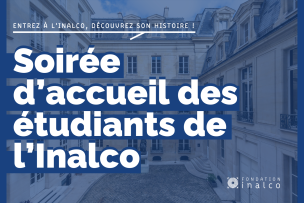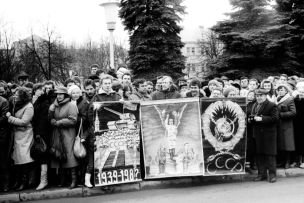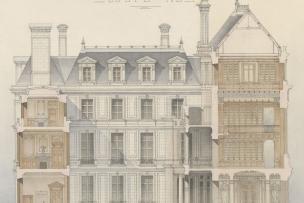A rich history
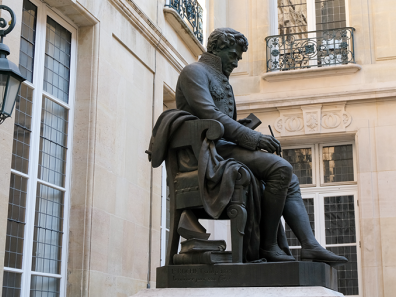
Key dates
1795 Creation of the École spéciale des langues orientales
1873 The School moves to 2 rue de Lille, Paris 7e
1914 The School changes its status and becomes École nationale des langues orientales vivantes (Enlov), it adopts the nickname of Langues O'
1971 The School becomes the Institut national des langues et civilisations orientales (Inalco)
1984 Inalco acquires the status of grand établissement
2010 Inalco is a founding member of Sorbonne Paris Cité
2011 Inalco moves all its courses to a single location at 65 rue des Grands Moulins, Paris 13e
2021 Inalco's Maison de la recherche is inaugurated at 2 rue de Lille, Paris 7e
The creation of Inalco
The creation of Inalco
At the time of the French Revolution, the desire was to have a French establishment complementary to the Collège de France dedicated to modern languages, whose purpose would be directed towards "vulgar and diplomatic idioms". Lakanal's report to the Constituante is explicit: "public and commercial utility alone must guide us in the choice of oriental languages to be taught".
In 1795; there was a shortage of interpreters at a time when trade and diplomacy were strategic elements in the spread of revolutionary ideas. It therefore became urgent to set up an institution responsible for preparing French people in the most appropriate way for the knowledge of the modern languages deemed useful by the Convention. Thus, at the most critical moment of the Terror, the Assembly of Representatives of the French People voted the founding charter of Inalco on 10 Germinal An III.
Under the terms of the founding decree, the School of Living Oriental Languages is "intended for the teaching of languages of recognized utility for politics and commerce"; the decree also states that it will be established within the precincts of the National Library, in order to have the scientific resources necessary for this learning.
.
Institutional and linguistic development
Institutional and linguistic development
The School is opened with three chairs: one of vulgar and literal Arabic, the second of Turkish and Crimean Tartar, the third of Persian and Malay. Events soon showed what important services the state could expect from the new institution. Barely three years after the decree of 10 Germinal, one of the School's teachers, Venture de Paradis, left as chief interpreter for the Egyptian army, taking his best students with him.
According to their success, the goal pursued by the Convention and continued by the Directoire had been achieved, as the School quickly put itself in a position to provide for the needs for which it had been created. In order to achieve this, the School did not hesitate to evolve its institution, to request premises in line with its teaching and to constantly increase the number of Oriental languages.
- During the 19th and 20th centuries, the School's status was modified on several occasions, enabling it to establish its specificity in a political context favorable to its expansion. The Royal Decree of May 22, 1838 aimed to bring the École des Langues Orientales into the university system as far as possible. The decree of November 8, 1869 reorganized the school to bring it into line with its "primitive destination": all the regulations were designed to give studies a more practical direction, without undermining the scientific character of the teaching. The School had to subtly combine its role as an establishment of high science, for which it was renowned in Europe, with its mission to train students capable of fulfilling the difficult role of interpreter in Eastern countries. Finally, the statute of June 8, 1914 confirms the previous orientations and grants the École the title of "grand établissement d'enseignement supérieur".
- For almost 70 years, the École's teaching mission was carried out in a small room at the Bibliothèque nationale. However, with the Universal Exhibition of 1867, the School acquired or donated a considerable number of oriental works and some ethnographic documents. As a result, it became impossible to find space for this increase in resources in the narrow space granted to the School's administration. Leaving the Bibliothèque nationale for good in 1868, the School moved temporarily into the apartments of the administrator of the Collège de France, before receiving a former private mansion at 2, rue de Lille in Paris in 1873, by decree of the President of the Republic. A great deal of work was carried out during the 1880s to provide an institutional and symbolic setting for the School's teaching missions.
- Four Oriental languages were established by the decree of Year III, and some 50 languages were included in the 1969-1970 syllabus: the teaching of the diversity of Oriental languages was on the move.
The digital and geographic explosion
The digital and geographic explosion
French higher education was facing many of the same problems as the École (soaring student numbers, shortage of teachers, insufficient teaching space, outdated learning methods). The events of 1968 led to a significant change in institutional structures and teaching practices.
The institutional consequence manifested itself in the change of name of the École, which in 1971 became the Institut national des langues et civilisations orientales, as well as its attachment to the University of Paris Sorbonne.
The very sharp increase in enrolments, combined with the spatial inadequacy of the historic building on the Rue de Lille, led to the geographical dispersal of teaching missions. As early as 1968, some courses were given "temporarily" in the buildings vacated by NATO at Porte Dauphine, then in 1969 other courses were moved to the Clichy university center, and in 1971 to the Asnières university center. From then on, Inalco was constantly on the lookout for temporary, buffer premises, enabling it to carry out its teaching missions.
Historical and collaborative unity
Historical and collaborative unity
While attachment to the University of Paris Sorbonne Nouvelle brought definite advantages to Inalco's administrative operation, differences in identity soon made Inalco's autonomy inevitable. Thanks to the Savary law of 1984, the Institute is classified as an independent "grand établissement".
After regaining institutional status, Inalco's ultimate battle lies in obtaining the geographical regrouping of its teaching. Several real estate projects came to nothing. It wasn't until the 2000s that the Pôle des langues et civilisations project emerged, integrating Inalco's teaching mission and the Bibliothèque universitaire des langues et civilisations in a single building. This real estate system has been in operation since September 2011.
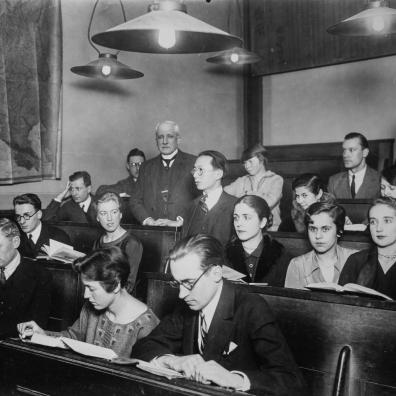
The story cycle that plunges you into the history of Inalco
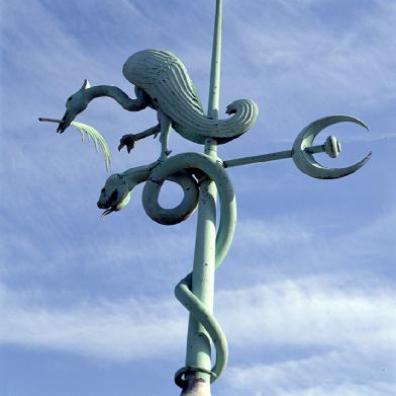
Find out more about Inalco's historical website
